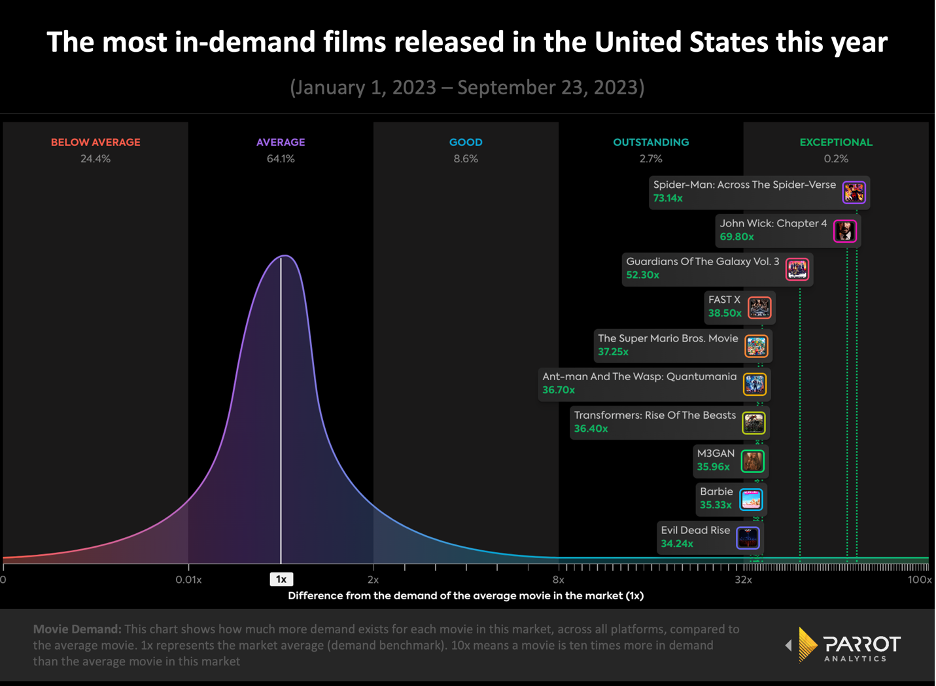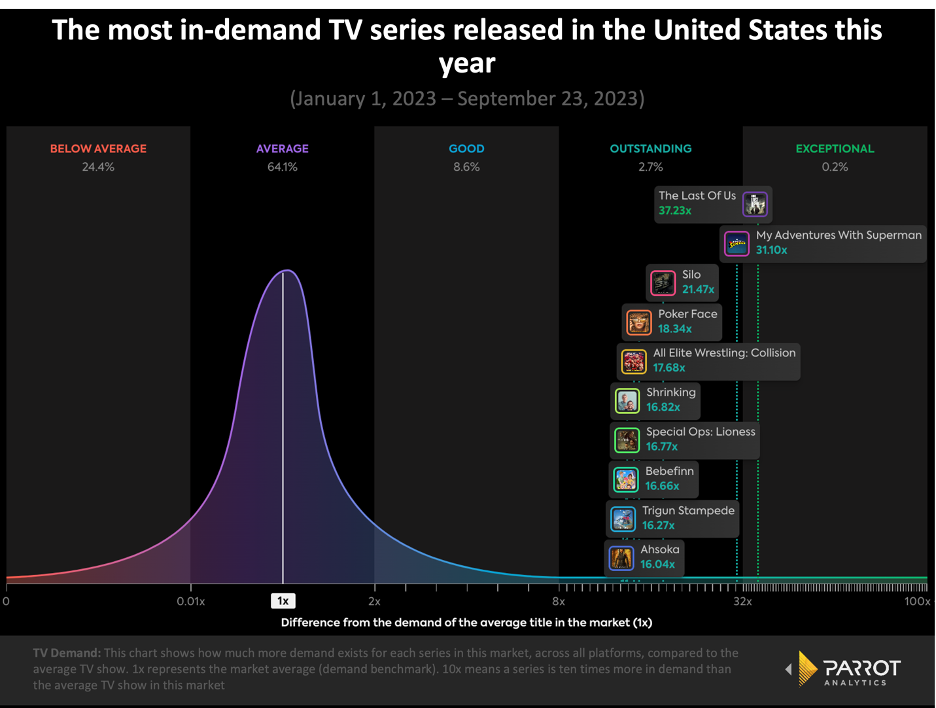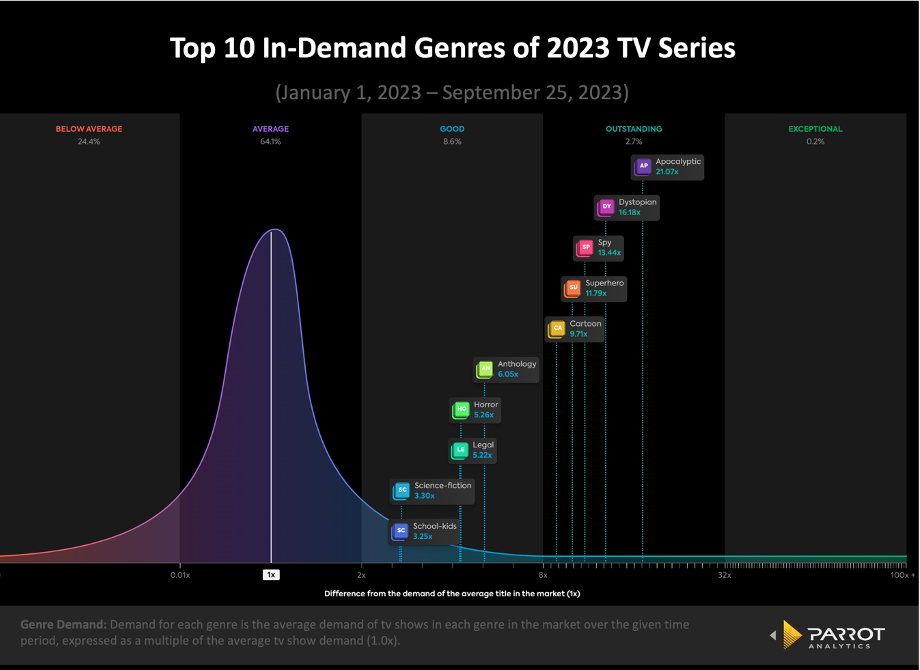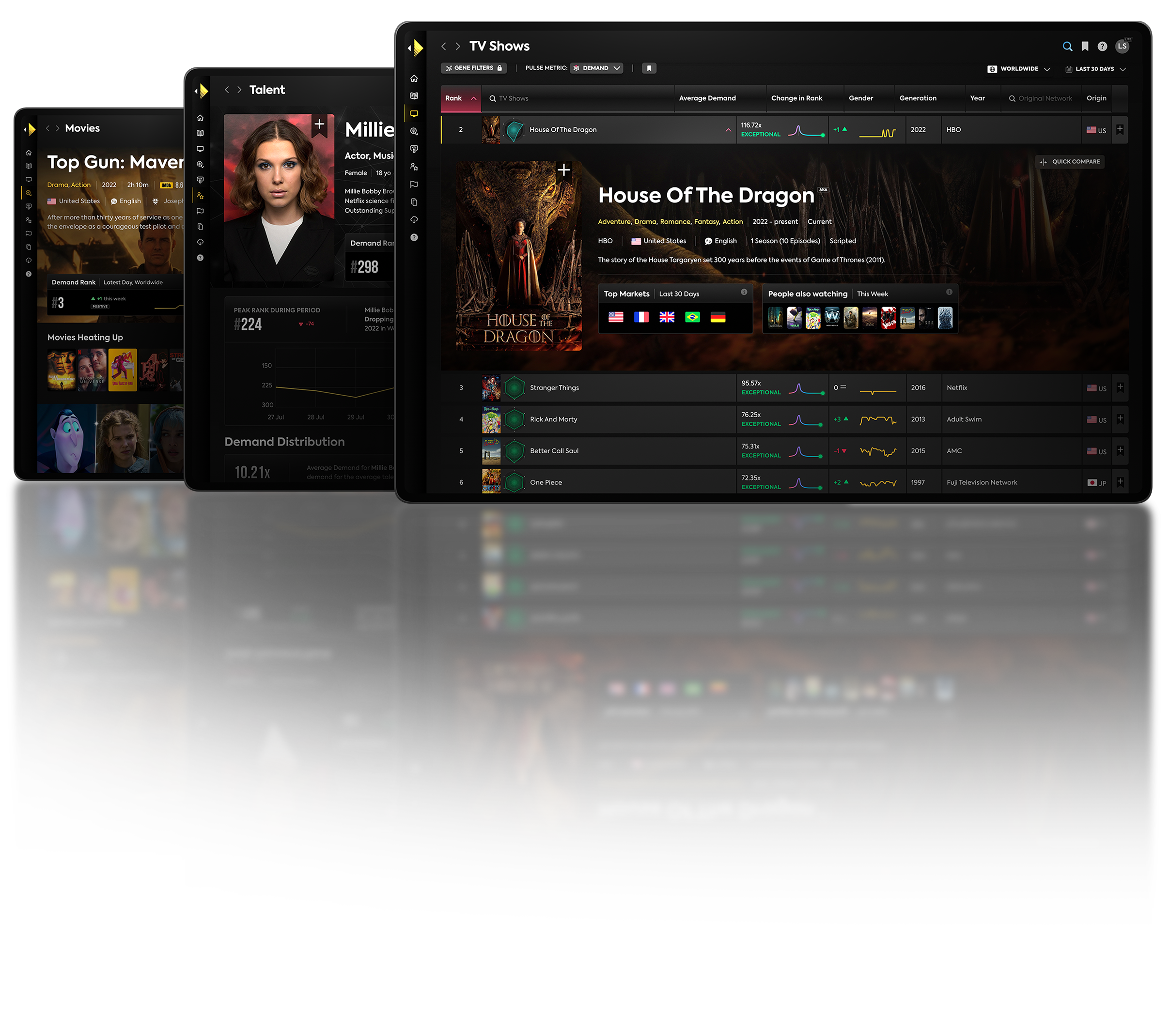2023 has been a landmark year for film and television, notable for its revival of in-theater audiences, a dual Hollywood strike for the first time in over 60 years, and fundamental changes in how content is distributed. With summer blockbuster season in the rearview and award circuit season just around the corner, now is a prudent time to do a retrospective on which genres have generated the most (or least) demand. By analyzing genre demand, one can understand the machinations behind the changes in the entertainment industry this year so far.
In-Demand Films of 2023

As evidenced by the chart above, t’s been a strong year for action films. Among the top ten films released this year by demand year-to-date, six have “action” listed as their primary genre by Parrot Analytics. Expanding the list to the top 20, that number becomes eleven, again an outright majority. The next closest genre to action is “adventure” with four films, a category usually designated to family and animation fare such as The Super Mario Bros. Movie and The Little Mermaid. After adventure, the only other two genres present in the top 20 in-demand films this year are “horror” (three) and “drama” (two).
In-Demand TV Series of 2023
When looking at the most in-demand television shows to have a first season released this year, the data is more diverse. In fact, action is not listed as the primary genre for any show inside the top 20, although many do have elements of action.

The most in-demand genre for TV this year is actually drama, with seven of the top 20 titles falling into that category. Interestingly, franchise fare such as Marvel’s Ahsoka and Secret Invasion are classified as “adventure”, the next most in-demand genre with six titles. This is a contrast from the top franchise films this year, like John Wick: Chapter 4 and Guardians Of The Galaxy Vol. 3, which are listed as action. A possible reason for this is that when it comes to long-form storytelling, television creators can’t simply rely on big action set pieces in the same way filmmakers do. Filmmakers are trying to draw audiences to theatres and hold their attention throughout. With television, storylines are more drawn out and episodes are shorter than films, so there is no need to amplify action sequences for the sake of maintaining audience attention. Additionally, what would probably be an action film in theaters sometimes becomes more of a prestige drama on television, as is the case with HBO’s The Last of Us, with characterization and dramatic tension taking center stage and the setting or subject serving as a unique backdrop.
Genre Demand
Below is a chart showing the average daily demand of 2023 released films within each of the top five genres from January 1 until present (September 23). It’s worth noting that genres often overlap with each other.

There doesn’t seem to be a lot of movement throughout the year when it comes to genres. Adventure is consistently on top, followed by action, horror, comedy, and drama, respectively. But still, these types of films do capture audience demand and retain it throughout the year. As previously discussed, an adventure film appeals to the widest range of audiences over any other genre due to its linkage with family, animation, and franchised action films, which are categories that tend to drive box office and streaming success. Although these films tend to be released during “blockbuster season” in the summer when kids are out of school, it makes sense that demand is still high during the first six months of the year as anticipation builds and trailers are released for the summer hits.
Now, here are the most in-demand genres for tv series, again represented against the average demand.

As evidenced by the chart, demand for genres tends to spike alongside new releases in that genre. For instance, the reason for “apocalyptic” and “dystopian” being the top two in-demand genres this year is reflective of HBO’s zombie thriller The Last of Us which released in January. Additionally, the demand for superhero series has remained elevated this year due to the steady release of IP-driven comic book series such as Marvel’s Secret Invasion. Overall, TV genre demand is more dynamic and granular than film demand, which seems to cluster around only a few big bucket categories.
What does it all mean?
On the whole, action and adventure are the two biggest drivers for demand when it comes to genres in film. Films in these genres appeal to a wide range of audiences and are generally released during the summer months when would-be moviegoers have more free time. Plus, these films lend themselves very easily to the franchise model of entertainment that has become so popular nowadays. We are seeing this especially with Disney’s Marvel and Star Wars properties. It makes sense that audience demand for action and adventure films stays elevated yearlong because as soon as one movie is released, the next in the series is already being teased, probably alongside several TV shows to accompany it. But dramas are not far behind, and as audiences start to experience franchise fatigue, a secular shift towards original fare could be possible, as hinted this summer by the success of Barbie and Oppenheimer. Furthermore, the horror film is certainly on the rise compared to previous years, likely due to the fact that horror tends to be one of the cheapest and easiest genres to produce. In today’s streaming landscape, hundreds of more films are being produced each year than in previous decades, leading to smaller budget or independent horror films.
On the television side, long form storytelling naturally lends itself to more drama than action or adventure. Of course, television series are getting shorter and shorter, so we could see a shift towards more spectacle-oriented television with budgets similar to action films. This has already started to take place to an extent, but with mixed success, as shows like The Rings of Power and House of the Dragon had gigantic budgets but only moderate acclaim among audiences. Additionally, TV genres fluctuate more from season to season, which makes sense given that shows are, well, seasonal in nature and are not often “eventized” in their marketing throughout the year in the same way that films are.
As new dramas are released this fall in anticipation of awards season for both film and television, it will be interesting to see if genre demand changes at all from current data. Regardless, it’s useful to analyze genre trends in order to get a better understanding of where the entertainment industry is at right now.



